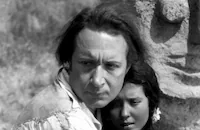Rose of Cimarron
Cast & Crew
Harry Keller
Jack Buetel
Mala Powers
Bill Williams
Jim Davis
Art Smith
Film Details
Technical Specs

Synopsis
After a wagon train traveling through Oklahoma is attacked by Comanche Indians, a young Cherokee named Willie Whitewater surveys the remains of the devastated train and finds a fair-skinned baby girl hidden in a trunk. He takes the infant to his parents, who name her "Rose of Cimarron" and rear her as they would their own Indian child. Years later, Rose's foster parents are murdered while trying to stop outlaws George Newcomb, Clem Dawley and Mike Finch from stealing their horses. When Rose discovers this, she vows revenge and goes in search of the three missing horses--a skewbald, a palomino and a sorrel. Rose's search takes her to Dodge City, where she seeks the aid of Marshal Hollister, known as one of the best lawmen in the West. Despite Hollister's attempt to persuade Rose that she must abide by the white man's law, which requires a fair trial before punishment can be meted out, she demands that the three outlaws be hanged immediately upon capture. Hollister and Rose soon fall in love, and Hollister promises repeatedly that he will bring the outlaws to justice. However, when Rose finds Dawley and Finch, she takes matters into her own hands and kills them in a gun battle. Hollister imprisons Rose and places her in a jail cell adjacent to Deacon, one of Newcomb's men. Soon after, Newcomb and one of his gunslingers, Rio, break Deacon out of jail, and Newcomb, who is attracted to Rose, frees her also. Newcomb realizes that he will have to murder Rose, however, due to her vendetta against her parents' killers, and arranges to have Dawley's younger brother, Jeb, ambush her. Jeb's attempts to shoot Rose fail, although Newcomb manages to convince her that Jeb, whom he shoots in the back, was the third man involved in the murders of Red Fawn and Lone Eagle. Meanwhile, back at Dodge City, Hollister realizes that his only hope of tracking down the outlaws is through Rose, and he attempts to lure her back by placing Willie under arrest on trumped-up charges. When Rose returns to Dodge City, she discovers that a $1,000 bounty has been placed on her head, and that Hollister is planning to transport Willie to a federal prison on the same eastbound train that the Newcomb gang is planning to rob. As the train speeds along, nearing a stretch of track that has been destroyed by the Newcomb gang, Rose, on horseback, manages to overtake it and climb on board. Once on the train, Rose pulls the emergency cord, thus preventing a train wreck. No sooner does the train come to a halt, however, than the outlaws begin looting the train's gold cargo. A blistering gun battle ensues, during which Deacon is seriously wounded, and Rose and Willie escape. As the outlaws flee, they bury the gold near a group of trees, then split up, with Rose and Willie taking Deacon. Newcomb circles around to get the gold and is confronted by Rio, who was also attempting to claim the loot. Newcomb shoots Rio, then joins Rose and Willie at a ranch hideout. There, Rose discovers, through Deacon's deathbed confession, that Newcomb is one of the men who killed her Indian foster parents. Hollister arrives, and although Newcomb makes an attempt to flee, Rose and Hollister catch up with him, and Hollister kills him. Satisfied with the demise of the Newcomb gang, Rose and Hollister ride off together to begin life anew.

Director
Harry Keller
Cast
Jack Buetel
Mala Powers

Bill Williams

Jim Davis
Art Smith

Bob Steele

Lillian Bronson
William Phipps

Irving Bacon
Dick Curtis
Alex Gerry

Monte Blue
Tom Monroe
Polly Burson
George Chandler
Tom Steele

John Doucette
Tommy Cook
William Schallert
Wade Crosby

Kenneth Macdonald

Byron Foulger
Argentina Brunetti
Tony Layng
Esther Howard
William Fawcett
Tex Terry
Charles Stevens
Hank Patterson
Frank Scannell
Martha Mitrovich
Lane Bradford
Edythe Elliott
Mira Mckinney
Marjorie Eaton
Ellanora Reeves
Claire Du Brey
Caleen Calder
Crew
Edward L. Alperson
Edward L. Alperson
Edward L. Alperson Jr.
Edward L. Alperson Jr.
Ernest Baldwin
Polly Burson
Ben Chapman
Ben Chapman
Earl Crane Sr.
Joan Erimen
Maurice Geraghty
Gene Hibbs
Wilton R. Holm
Hazel Keithley
Raoul Kraushaar
S. Kring
Boris Leven
Pat Marlowe
Gordon Mclean
Herb Mendelson
Fay Moore
Norma
Arthur Roberts
Clifford Shank
Norman Skeete
Tom Steele
Karl Struss
Al Zimbalist

Film Details
Technical Specs

Quotes
Trivia
Notes
Although most sources list this film's production company as Edward L. Alperson Productions, Inc., the copyright registration gives it as Alco Pictures Corp., another Alperson-owned company. A July 1951 Hollywood Reporter news item includes Paul Hurst in the cast, but he was not seen in the viewed print. A modern source adds Frank Ferguson to the cast, but he also was not seen in the viewed print. Mala Powers and Jack Buetel were borrowed from Howard Hughes, who had them under personal contract, for the picture. Hollywood Reporter production charts indicate that exteriors were shot in Topanga Canyon, near Los Angeles.












